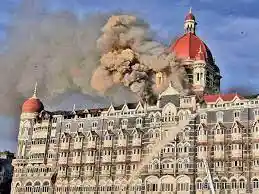...And it finally ended
Being stuck in a terrifying situation is like having a nightmare playing on loop each time you go to sleep. But can you imagine being in a situation for three days when you don't know if you'd live or die? When does the nightmare truly end?

The face of destruction in terror. Image source: Economic Times
We'd all heard stories of terrorism. But in 2008, those stories ceased to be stories- they came to life.
While India was going about its routine, a little political tussle here and there, some economic measures to be taken, people complaining about the weather, hygiene, food, and education, something else was brewing up in the sea. A storm was going to hit Mumbai and ravage it completely, the memory of which would scar people for years to come.
On 26th November 2008, ten Pakistani militants wreaked havoc that India hadn't imagined. The militant arrived by sea and blended with the crowds of Mumbai. They hijacked vehicles, attacked the Leopold Cafe, the Mumbai Chabad House, a railway station, the Oberoi Trident, the Taj Mahal Palace hotel, and the Cama hospital.
The terrorists had these sole purposes in their minds: instill fear, kill as many people as possible, and inflict unforgettable damage to Mumbai.
When the police got a whiff of the attacks and were alerted to terrorists keeping the guests as hostages at the Taj Mahal Palace hotel, a few of the local police officers rushed to the spot.
New Delhi was made aware of the attacks shortly. While everyone hoped the terror would end with the night, nobody knew this saga of fear would go on for the next three days.
While some places were bombed by tossing grenades, others witnessed the terrorists' cold brutality as they gunned down civilians mercilessly. Since the militants had attacked the busiest places in Mumbai, it became even more crucial for the authorities to proceed with caution. They couldn't afford to jeopardize the situation more.
On 27th November, the special forces (200 NSG commandos) arrived from Delhi, and they began rescuing hostages in batches. The mission was to be performed very discreetly and carefully because they couldn't afford to lose any more civilians. The constant explosions in the Taj and Oberoi and Trident hotels meant that commandos could not directly enter the premises.
The commandos had landed on top of the buildings by helicopters. The commandos successfully seized control of the hotels and the Nariman house. In the Taj Mahal Palace hotel, 30 people were killed.
The entire incident came to an end at 9:00 a.m. on 29th November 2008.
During this dastardly attack, 172 people died. The dead included Mumbaikars, local policemen, the staff that did its best to protect everyone, and foreign nationals staying at the hotels.
Those who made it out alive say that their cell phones were instrumental in their survival. The nation remembers the people who sacrificed their lives while trying o fight this evil, and it also mourns the loss of life witnessed during these attacks.
While the death of a loved one is an unfathomable loss, we take comfort in the fact that the perpetrators of the 26/11 attacks were punished for their crimes.


